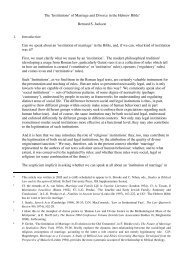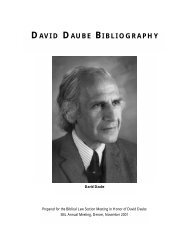Here - Deborah Charles Publications
Here - Deborah Charles Publications
Here - Deborah Charles Publications
You also want an ePaper? Increase the reach of your titles
YUMPU automatically turns print PDFs into web optimized ePapers that Google loves.
- 37 –not limited to aggadic traditions, but also applies to halakhic ones, and is reflected in Ephrem’s legal terminology as well as hislegal thought and practice. Comparing Ephrem’s legal terminology in issues of betrothal, marriage, adultery, and divorce with thatused in contemporary and earlier Jewish, Christian, and Roman sources, reveals the deep influence of rabbinic terminology onEphrem’s terminology. This influence is apparent in two aspects of Ephrem’s language: his vocabulary and the semantic coverageof his terminology. In both these areas, he has more in common with the rabbinic terminology and its usage, than with that ofRoman law and Christian writers. Furthermore, in some of the cases it is possible to determine that Ephrem’s legal terminology isclosely related to Palestinian terminology in particular. This conclusion emphasizes the distance between Ephrem and his Greekand Latin Christian contemporaries, and reflects his deep ties to Jewish legal traditions, ties which are a result not only of a similarlanguage but also of similar legal views.Yifat Monnickendam completed her tenure as a Crane Foundation Post-Doctoral Fellow at the Jewish Studies Program,Johns Hopkins University, as well as a Visiting Scholar at the Catholic University of America’s Center for the Study ofEarly Christianity (2010-2012). She specializes in the comparative study of Jewish, Christian, and Roman sources fromantiquity to early Byzantium, viewing them through the lens of legal issues. In the coming year she will join the MartinBuber Society of Fellows at the Hebrew University of Jerusalem, where she will be working on her next project, the Syro-Roman Lawbook, and its relation to Jewish, Roman and Christian legal traditions.Leib MoscovitzLeib Moscovitz, “Peshat-Based Conceptualization”: Some Observations on the Halakhic-Exegetical Methodology of R. IsaacZe’ev Soloveitchik (Session 11B)An extremely innovative approach to the interpretation and analysis of the Talmud and Maimonides’ Mishneh Torah, basedprimarily on abstract conceptual analysis, was developed in the early twentieth century by R. Chaim Soloveitchik of Brest-Litovsk(Brisk). In this paper, I propose to analyze a significant and somewhat startling variant of R. Chaim’s approach, as manifest in thewritings of his son, R. Isaac Ze’ev (henceforth: RIZS). Like his father, RIZS adopted a conceptualist approach to the interpretationof rabbinic sources, which placed considerable emphasis on the identification of seemingly similar, though ultimately distinct, legalprinciples (shnei dinim) potentially applicable to particular cases. However, while the distinctions and categories introduced by R.Chaim frequently seem completely at odds with the plain sense of the relevant texts, those utilized by RIZS very often seem toreflect the plain sense of those texts. Often these distinctions and categories seem self-evident or logically necessary, whileelsewhere they emerge almost explicitly from other Talmudic passages or from the writings of post-talmudic commentators.In this paper, I propose to illustrate this phenomenon, to account for the differences between RIZS’s approach and his father’s, andto analyze the nature of RIZS’s halakhic creativity.Leib Moscovitz is a Professor in the Department of Talmud in Bar-Ilan University, where he currently serves asdepartment chair. His research focuses on two principal areas: the Talmud Yerushalmi, and the history of the halakhahand rabbinic legal thought. He has served in the past as an editor of Jewish Law Association Studies and as director of theJewish Law Association <strong>Publications</strong> department. He also serves on the editorial boards of various scholarly journals,such as Dine Israel and JSIJ (Jewish Studies, an Internet Journal). David NimmerDavid Nimmer (UCLA School of Law) – Austrian Law as the Template for a Halakhic Ruling (Session 5B)In 1860, Joseph Saul Nathanson authored a copyright teshuva. The Sho’el u-Meishiv invoked the dictum that “our wholesomeTorah is not like your idle chatter,” reasoning from protection under Austrian law to conclude that halakha can be no lesssolicitous. The logic was that if Gentile law recognizes X, Jewish law must do so all the more so. Yet, instead of invokingcopyright law, he overtly mentioned the invention of a machine—which comes from the neighboring domain of patent law.Nonetheless, one may presume that Nathanson knew of the Austrian Law for Protection of Literary and Artistic Property (1846).Nathanson rooted copyright protection in property law. Previous decisors had invoked other rationales—such as a rabbinic heremor an interpretation of hasagat gevul. By contrast, the position of the Sho’el u-Meishiv is far more categorical. Nathanson’s





